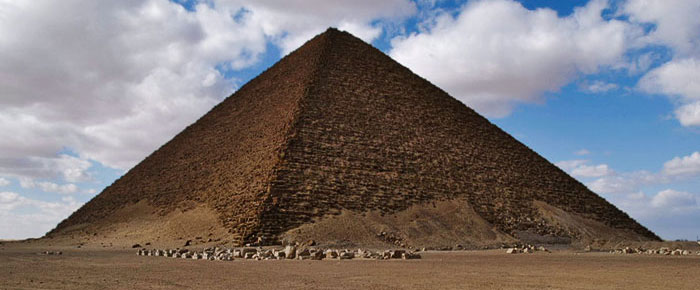Sneferu was one of the most prolific builders of Ancient Egypt. Not content with building a step pyramid at Meidum and the Bent Pyramid at Dashur, Sneferu also built the Red Pyramid (also known as the North Pyramid) at Dashur. It is often suggested that he was very keen to built a true pyramid and that he was displeased when he was forced to change the angle of the Bent Pyramid, as the weight of masonry threatened to cause that pyramid to collapse. Whether this is the case or not the angle of the red pyramid is close to the top section of the Bent Pyramid (around 43 degrees).

The Red Pyramid derives its modern name from the red limestone of its masonry. However, it is known as el-haram el-watwat (Bat Pyramid) by the local population. When it was first built it was clad with fine white limestone and was named “Sneferu Shines”, “Sneferu Rises” or “Sneferu Appears”. It is the largest of the pyramids of Dashur and the third largest pyramid in Egypt.


Most of the white limestone casing of the pyramid was removed and used in the building of Cairo. However, some blocks remain and many of these had inscriptions on the inward facing sides naming Sneferu. Others bear the names of the work crews who placed the blocks and many are dated. Using these blocks it is estimated that building began between the twenty-second and twenty-ninth years of the reign of Sneferu and that the entire pyramid took around seventeen years to build.

A pyramidion (cap stone) which may have been intended for this pyramid has been recovered and is on display in Dashur. However, some experts have pointed out that the slope of the pyramidion is different from that of the pyramid and so it may never have been installed on the pyramid and may in fact be linked to a different monument.
Pyramid layout
The entrance is cut into the north face of the pyramid. A descending passage leads to a chamber with a corbelled roof. At the south-west end of the chamber a short corridor leads to a further chamber with a corbelled roof which sits directly below the apex of the pyramid. An opening cut high into the south wall leads to a third chamber with a corbelled roof. The floor of this chamber is sunk below the level of the passageway and is very rough, and it is speculated that it was hacked up by tomb robbers searching for treasure.


Mortuary temple
It is thought that the mortuary temple on the east side of the pyramid was built in a hurry when Sneferu died. It is now almost entirely ruined but efforts have been made to reconstruct it. It is believed to have included depictions of the Heb Sed Festival and housed a pink granite false door and a series of store rooms.
Valley temple and causeway
The valley temple has not yet been excavated and it is not clear that the causeway, which would normally connect the valley temple with the pyramid and mortuary temple, was ever built.
Bibliography
- Bard, Kathryn (2008) An introduction to the Archaeology of Ancient Egypt
- Kemp, Barry J (1991) Ancient Egypt: Anatomy of a Civilisation
- Lehner, Mark (1997) The Complete Pyramids
- Malek, J (2000) “The Old Kingdom”, in The Oxford History of Ancient Egypt Ed I. Shaw
- Verner, Miroslav (1997)The Pyramids
Copyright J Hill 2016